Quick search
CTRL+K
Quick search
CTRL+K

Vienna is the city of elegance, and it is the heart of the former Holy Roman and Austrian empires. It is thereby the center of the fantastic history of the Habsburg dynasty and the capital of classical music, with all the magnificent buildings, the emperors and state have built during the last many centuries.
Nearly everywhere, there are historic buildings and great art that the Habsburg emperors have been at the forefront of. Enormous sums of money were invested in beauty and in the classic culture, which for many is the epitome of Baroque Vienna in particular.
Hofburg formed the center of power in the Habsburg Empire, and the castle and the many beautiful buildings in the castle complex are among Vienna’s absolute top attractions. This is also where you find the Spanish Riding School and the famous Treasury.
It is certainly not without reason that composers such as Beethoven and Mozart were inspired by the beautiful capital. Vienna cafes, museums, streets, squares and much more as the famous Ferris wheel in the Prater Park are some of the experiences in the Austrian capital. A piece of Sachertorte at Hotel Sacher is also a good choice of a genuine Viennese experience.
If you want to see what is around the city center, make a trip to the imperial palace of Schönbrunn, which is close by. The lavish palace and castle park is a great place to visit. It is also not far to the Danube and to exciting places such as the excavations of ancient Roman settlements and the capital of Slovakia, Bratislava.
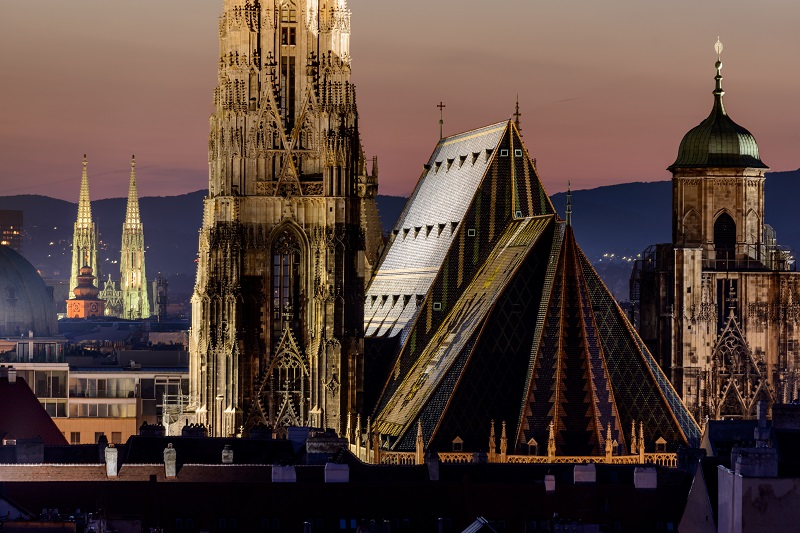
Vienna’s cathedral is called Stephansdom, and it stands as one of the city’s landmarks. Its history goes back to the 12th century, when Vienna had achieved great importance in the German-speaking area. A larger church building was needed to supplement the existing parish churches.
The first church in the Romanesque style was consecrated in 1147. In 1258, the already extended church building burned down, and in the successor, the tower-adorned facade was reused in the larger church, which could be consecrated in 1263. In the following centuries, and mainly until 1511, Stephansdom was continuously expanded . The 137-metre high south tower was completed in 1433 after 65 years of construction, while the north tower, which had been started, was not completed, and instead of a Gothic twin tower for the south tower, in 1578 it got the current Renaissance top.
Stephansdom’s colorful roof was created from 230,000 glazed tiles, which were, among other things, laid as an image of the Habsburg double-headed eagle. You can also see the coat of arms of Vienna and Austria in the pattern of the roof.
Inside there are a number of altars, of which the main altar with the painting from 1647 of Saint Stephen’s martyrdom is particularly worth seeing. The Vienna-Neustädter Altar from 1447 is also worth a look with its colorful carvings. Emperor Frederik III is buried in the church, and besides that you can see the large crypt.
The residential block Hundertwasserhaus is one of Vienna’s most visited and photographed places, and you understand that when you stand in front of its many colors, the crooked angles and the trees and bushes on top of the house.
The brightly colored house was designed by the Austrian artist Friedensreich Hundertwasser and built in the years 1983-1985. Inside, it is furnished with ordinary tenants, and in connection with the project, Hundertwasser did not want payment for the task, it was enough for him that an ugly alternative to his own house was not built.
Wiener Riesenrad is a 65 meter high Ferris wheel which has become one of Vienna’s landmarks. The Ferris wheel was built as a technical masterpiece in 1897 in Vienna’s then new amusement area, which included a miniature Venice with canals and Venetian palaces.
During the heavy destruction in Vienna in 1945, the Wiener Riesenrad was also destroyed, but almost as a symbol of the steely will of the Viennese, the Ferris wheel was rebuilt after a short time. However, there are now just 15 cabins compared to the original 30, and in the cabins you can, among other things, arrange seated dinner parties.
In the exhibition hall on the ground floor, you can see very beautifully constructed mechanical landscapes and scenes from the history of Vienna and the Riesenrad. The Ferris wheel is known, among other things, from the film The Third Man about Vienna in the years after the end of World War II.
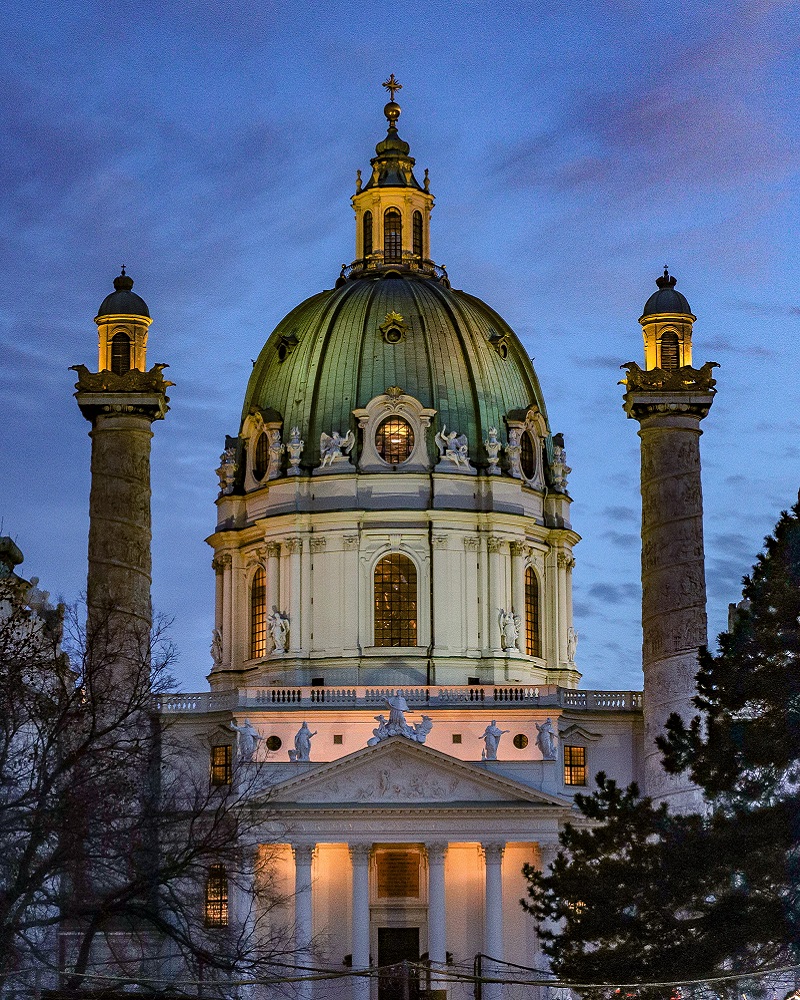
Karlskirche is an impressive baroque church that was built in the years 1716-1737 by Emperor Karl VI. The reason was that the emperor wanted to build a church in honor of the patron saint Karl Borromäus, who was referred to as a person who in 1713 cured Vienna of the plague that ravaged the city.
The location of this prestigious building was chosen so that the Karlskirche came to lie high in the landscape on the road between Vienna and the summer palace of Theresianum.
Karlskirche is the most important church in Austria after the Vienna Cathedral, Stephansdom. The church measures 80×60 meters in ground plan, and the large dome reaches a height of 72 meters. The two oriental-inspired columns in front are 33 meters high and were inspired by Trajan’s Column in Rome. The facade facing Karlsplatz is impressive and was built in the Greek temple style.
Inside you can see beautiful ornamentation and fine paintings. Together with those in Schönbrunn Palace, these are some of the finest frescoes of the time, and overall the building is a fine example of the positive mood that characterized the country after the successful end of the wars against the Turks.
The large Hofburg palace complex was the heart of the Habsburg Empire for many centuries. Since 1279, the Hofburg has been the documented political center of several dynasties in a number of kingdoms such as Austria-Hungary. Today, the address is still the official residence of the Austrian president, and thus the formal political leadership of the country is still present in the complex despite the abolition of the monarchy in the 20th century.
The Hofburg functioned as the winter palace of the Habsburgs, while Schönbrunn on the western outskirts of Vienna was the summer residence. The enormous castle complex was begun in 1275 and only completed in 1926. However, there was great variation in the building activity over the many centuries, which also characterizes the interior design and architecture. Broadly speaking, the estate consists of various residence buildings, churches, museums, the court library, the treasury, riding school and stable buildings.
There is plenty to see on a visit to the Hofburg, which is arranged like many different museums. In the Neue Burg there are, for example, fine collections of weapons and armor (Hofjagd- und Rüstkammer), old musical instruments (Sammlung alter Musikinstrumente), the ethnological museum (Museum für Völkerkunde) and the archaeological museum specializing in the excavations in Ephesos (Ephesos Museum). You can also visit the Treasury, the Castle Church and the Spanish Court Riding School as other well-known highlights.
Heldenplatz is the name of the central square in front of the Hofburg palace complex. From here you can clearly see the grandeur and wealth of the Habsburg empire and building style. The president of Austria now has a residence in the buildings on Heldenplatz’s north-east side, while the Hofburg was formerly the residence of the country’s monarchs.
Heldenplatz was laid out under Emperor Franz Joseph I, and it was originally intended that it, together with the Neue Burg and a number of magnificent buildings on the current park area of the Volkspark, should form the so-called Kaiserforum. It was Gottfried Semper who was behind the drawings of the Kaiserforum, which was never realized.
On Heldenplatz you can see two equestrian statues today. One is of Prince Eugene of Savoy, while the other is of Archduke Charles of Austria-Teschen, who was the first to inflict defeat on Napoleon on the battlefield. To the southwest at the exit towards the Ringstraße is the outer castle gate, Äußeres Burgtor.
Incidentally, Heldenplatz became historic in recent times. It was here that the Austrian union with the German Empire took place in the years before the Second World War. The merger took place in the so-called Anschluß in 1938.
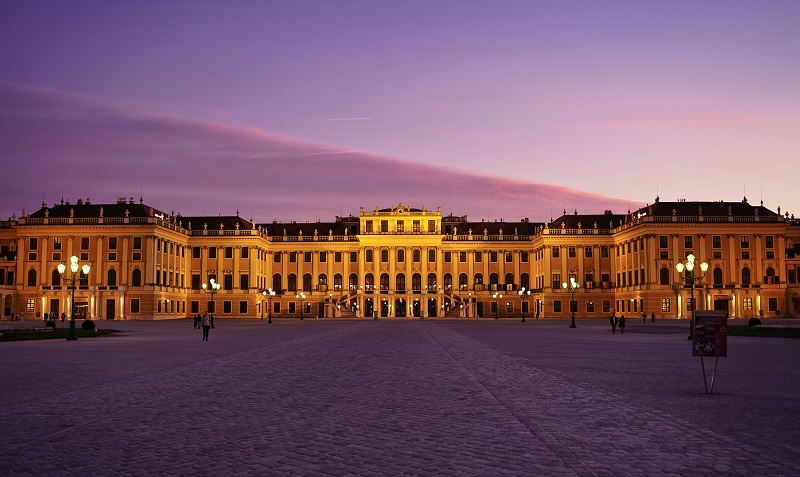
Schönbrunn Palace, which was the summer residence of the Habsburgs, is one of Europe’s finest and most impressive Baroque castles. The imperial history of the place started with Emperor Maximilian II’s purchase of the area in 1569. In 1548, the previous owner had erected a smaller building, Katterburg, which the emperor had fenced off together with the area around the house. Animals were set out and thus a hunting ground was created and one day the emperor saw a beautiful spring at the place and the place was named after that. Hence the name Schönbrunn.
In connection with the battles against the Turks in 1683, the then expanded Katterburg was destroyed, and this gave Emperor Leopold I the opportunity to build the current Schönbrunn castle. It was Johann Fischer von Erlach who was responsible for the drawings, and his inspiration was, among other things, wanting to surpass the Versailles of the French sun kings.
The construction of Erlach’s Schloß Schönbrunn started in 1696, but it was especially Empress Maria Theresia who later came to leave her mark on the facility. Maria Theresia decided to use Schönbrunn as a summer residence, and she asked the architect Nikolaus con Pacassi to remodel and expand Erlach’s castle in the rococo style of the time.
The entrance to Schönbrunn is over the 24,000 square meter Court of Honor/Ehrenhof, whose two obelisks were erected under Napoleon. Inside the castle you can see many rooms and halls. Here are just a few of those that are accessible during a tour.
The Great Gallery/Große Galerie is Schönbrunn’s most impressive hall. It is 40×10 meters and lavishly decorated. In the imperial era, the hall was used for balls and large tables, and it was here that the Congress of Vienna was held in 1814-1815. In recent times, it was here that the Soviet Union’s Nikita Khrushchev and the USA’s John F. Kennedy met in 1961. The Little Gallery/Kleine Galerie is magnificently decorated like the Great Gallery, and here Maria Theresia held smaller parties.
The Chinese Cabinet/Chinesische Kabinett is characterized by the 18th-century fascination with Chinese, with lacquer and wood on the walls, among other things. It was here that Maria Theresia held private conferences with the chancellor. Another oriental-inspired room is the Blue Chinese Salon/Blauer Chinesischer Salon, where the last negotiations took place with the emperor in 1918 in connection with the country’s transition to a republic. Charles I became the last emperor when he signed the document that dissolved the monarchy.
Next to the Blue Chinese Salon is the Viex-Laque-Zimmer, which was Emperor Franz I Stephan’s study. After his sudden death in 1765, Maria Theresia had the room decorated as a memorial room, and it was in this connection that the black lacquer inserts in the walls were installed.
In the Mirror Room/Spiegelzimmer, the only 6-year-old Wolfgang Amadeus Mozart played his first concert for Empress Maria Theresia. The beautiful rococo decoration is typical of Maria Theresa’s time. The Castle Chapel/Schloßkapelle is Schönbrunn’s church and one of the interiors that has remained largely unchanged since Johann Fischer von Erlach’s castle.
Schönbrunn’s large palace park is elegantly laid out like the castle, and it was part of Maria Theresa’s plan from the 1770s. From the castle, a central facility runs towards the Neptunspringvandet/Neptunbrunnen and on towards the Gloriette arcade, which visually rounds off the castle park on the horizon.
In the park you also come across some Roman ruins, Römische Ruine. These were newly built as ruins in 1778 and form one of the area’s exotic facilities. You can also see a Japanese garden, and the Vienna Zoo is set up in part of the park. There used to be a Dutch garden, but in 1881-1882 the 113 meter long tropical greenhouse Palmenhaus was built, and here you will find many exotic growths.
The Wagenburg in the eastern part of Schönbrunn is the Imperial Carriage House, where the vehicles of the Imperial Family are exhibited. Here stands, among other things, the gilded coronation vessel. In the garden, of course, there is also the Schöner Brunnen spring, which has given the castle its name. If you drink the water from here, it is said to give you beauty.
Austria’s parliament building was built by the Danish architect Theophil Edvard Hansen in the years 1874-1883. The building style was monumental Greek, and Hansen designed the building as an ensemble, which means that he was behind both the external and internal decoration.
In front of the entrance stands the complex’s best-known statue, the Pallas Athene statue from 1902. In the statue, Athene holds the goddess Nike in her hand.
From the start, the official name for the construction was the Reichsratsgebäude, but especially when Austria became a republic in 1918 the word parliament came into use. The building houses both chambers of the Austrian Parliament. They are respectively called the Bundesrat and the Nationalrat.
Votivkirche is Vienna’s most significant neo-Gothic monument and among the finest in the world in this style. The church was built in gratitude by the Austro-Hungarian Emperor Franz Josef I, who in 1853 survived a knife attack by the Hungarian János Libényi in this very place. The financing was set in motion by Franz Josef I’s brother Ferdinand Maximilian Josef through a collection of gratitude gifts to God, the Votive Gift, from which the church’s name derives. Construction was started in 1856 and completed in 1879.
The Votivkirche’s structure is like a classic Gothic cathedral. Most striking are the two slender towers, which reach a height of 99 metres. In addition to the towers, there is also a beautiful rose window in the facade. That the interior of the church is the main altar is quite worth seeing. It was created with inspiration from Italian Gothic. The altar was made of marble with columns of alabaster.
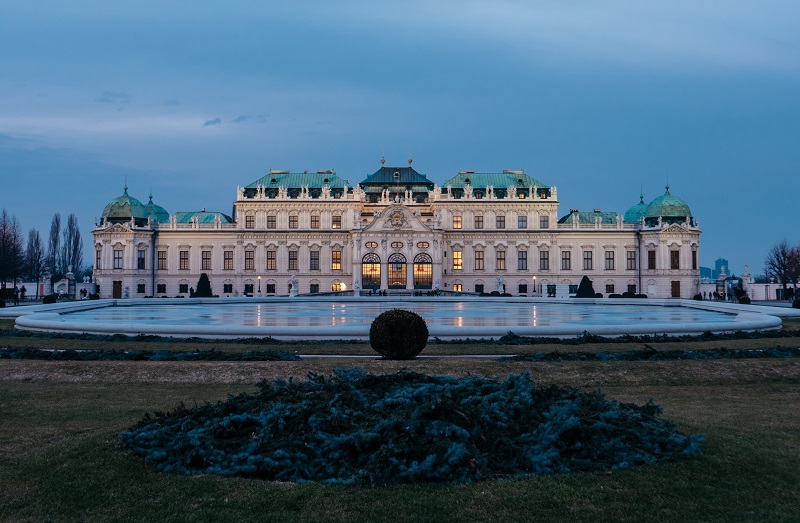
Belvedere is a beautiful castle that sits like a lovely and elegant breather in the Austrian capital. The castle is more of a castle complex consisting of three parts; the two castles Upper Belvedere/Oberes Belvedere and Lower Belvedere/Unteres Belvedere and a very beautiful garden.
The Belvedere was built by Prince Eugene of Savoy. Eugen gave the architect Johann Lucas von Hildebrandt the task in 1714, and the large pleasure palace Lower Belvedere was already completed two years later. Lower Belvedere was not planned for much living, but rather with beautiful halls, stables and as an orangery. The central room is the Marmorsalen/Marmorsaal, in which the original figures from the Providentiabrunnen fountain on the Neuer Markt can be seen.
The garden, which is primarily located between the two Belvedere castles, is the oldest part of the complex. It was laid out according to the French model already shortly after the purchase of the land in 1700. As the Upper Belvedere is slightly higher than the Lower Belvedere, the choice fell on a terraced garden with sculptures, the theme of which is the Olympus of Greek mythology.
Upper Belvedere was originally intended as a smaller building that was supposed to act decoratively as the end of the garden. However, it was changed so that it could be the palace complex’s summer residence for Prince Eugen. The building was completed after two years of construction in 1723, but Prince Eugen still lived in the fewer living rooms in the Lower Belvedere, and the Upper Belvedere was primarily used for representation.
Later, Upper Belvedere became the residence of the Habsburgs, and the last resident was the successor to the throne, Archduke Franz Ferdinand, who was killed in 1914. In 1955, the Austrian constitution was also signed in Upper Belvedere, and thus modern Austria was formally established here.
There is both access to the garden and to both castle buildings. They are designed as exhibition rooms, but of course the buildings themselves are also worth a visit in themselves. The terrace garden is located between Upper and Lower Belvedere, but there is also a beautiful and worth-seeing facility south of Upper Belvedere.
Here in the Figarohaus is one of the only preserved apartments of the composer Wolfgang Amadeus Mozart. In 1781, Mozart moved from Salzburg to Vienna, and in the years 1784-1787 he lived here in the Figarohaus, whose name comes from the fact that Mozart, among other things, composed The Marriage of Figaro in the apartment.
The museum apartment is furnished as it was in Mozart’s time, and together with the modern exhibition about the composer’s life and works in the Mozarthaus next to the Figarohaus, the place gives an elegant overall impression of Mozart’s world.
Karlsplatz is one of Vienna’s well-known squares. It was laid out by Emperor Karl VI in the early 1700s in a different version than today’s square, which is quite busy. However, you can also see several sights on and around Karlsplatz.
The large Karlskirche dominates the impression together with the fine pavilion that stands in the middle of the square. The pavilion was built in Art Nouveau style and opened in 1899 as the Akademiestraße S-Bahn station. When the station was changed to a subway in 1981, the pavilion closed as a station.
On the north side of the square is the Musikverein concert hall, where every year there is a New Year’s concert in the impressive Gyldne Sal/Goldener Saal, where there is room for 2,000 spectators. Next to the Musikverein you can see the Künstlerhaus building, which was built as the Musikverein in the 1860s. To the south on Karlsplatz is the Technical University of Vienna, whose main building from 1816 is adorned with statues of celebrities in engineering and science.
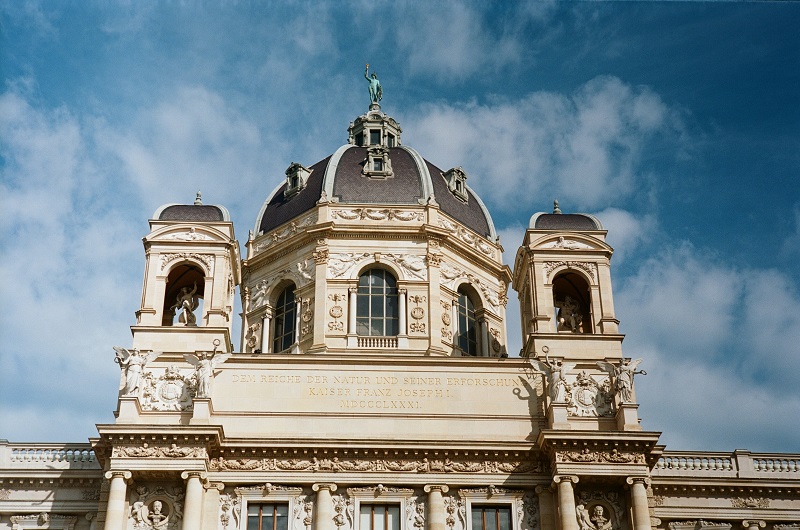
The elegant square Maria-Theresien-Platz was laid out in the late 19th century as one of the only completed parts of the grand plan for the new Hofburg, Kaiserforum, conceived by the architect Gottfried Semper. Semper is also known, among other things, for Dresden’s famous Semperopera.
In the middle of Maria-Theresien-Platz stands Vienna’s large monument to Empress Maria Theresia, and along the sides of the square are the large twin buildings that house the art history and natural history museums in the city respectively. Both buildings were built in the Imperial Renaissance style with lavish furnishings in all rooms.
The great Habsburg Hofburg is located as a large building complex in Vienna, and you can see several museums and collections in the facility. In the entrance in the gate under the Michaelerkuppel are the Kaiserappartements, the Silberkammer and the Sisi Museum.
The Kaiserappartements were some of the imperial family’s private apartments at the Hofburg, and they are furnished as in the imperial era. The interior is primarily in Rococo, and in addition to private rooms and effects, there is also access to Emperor Franz Joseph’s study and several halls for official use.
In the Silberkammer you can see an exhibition of the imperial family’s service. In the exhibition, a long table is set up, among other things, so that you get a good impression of a dinner situation in the imperial era.
The Sisi Museum is an exciting exhibition about the beautiful Empress Elisabeth, whose person and history are surrounded by myths and good stories.
The famous Spanish Riding School is located in the Stallburg building. The institution is believed to have been established in 1572, and it got its name from the Spanish horses that were bred and trained here. The horses are known as Lipizzaner horses, and that name comes from the stud farm Lipizza, which was also founded by the emperor in the 16th century. Today, the white horses are bred at the stud farm Bundesgestüt Piber in the town of Piber.
There are different buildings for the riding school. In the period 1729-1735, Emperor Karl VI had the particularly beautifully decorated Winter Riding School/Winterreitschule built. Equestrian shows are still held here, and during the country’s imperial era, the court could take a seat in a special lodge. It was also in this hall that Napoleon’s wedding dinner in 1810 was held.
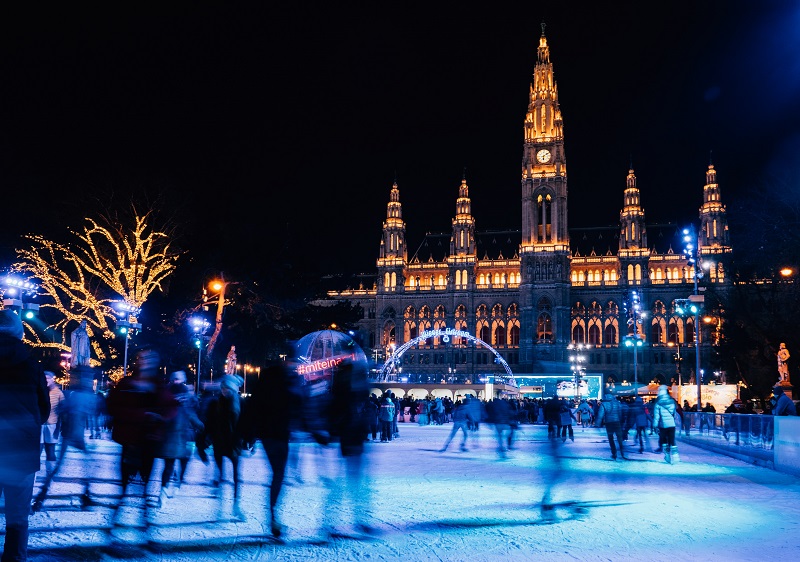
Vienna’s Neo-Gothic Town Hall was built in 1872-1883 by Friedrich von Schmidt. It houses both the city of Vienna’s administration and the mayor’s office, as well as the region’s parliament. The dominant part of the building is the central tower, which measures 98 meters in height. At the top of the tower stands the 3.4 meter tall figure Rådhusman/Rathausmann, which was cast in wrought iron in 1882.
The most impressive of the town hall’s more than 1,500 rooms and halls is the Festsalen/Festsaal, which contains statues of important people from Vienna. In front of the building is the green facility Rathauspark, which was laid out in the 1800s on an area that previously functioned as an exercise field.
Peterskirche is one of central Vienna’s atmospheric churches. Its history goes back to the early Middle Ages, but the original Romanesque building burned in 1661. The ruin was urgently repaired, but the emperor decided at the same time that a new church should be built. The new and current Peterskirche was mainly built in the years 1701-1722, but was not inaugurated until 1733.
The church was the first domed church in baroque Vienna, and despite a relatively small area to build on, it is a large and airy church space that you enter. The interior is quite overwhelming with the fine and rich stucco and other decoration.
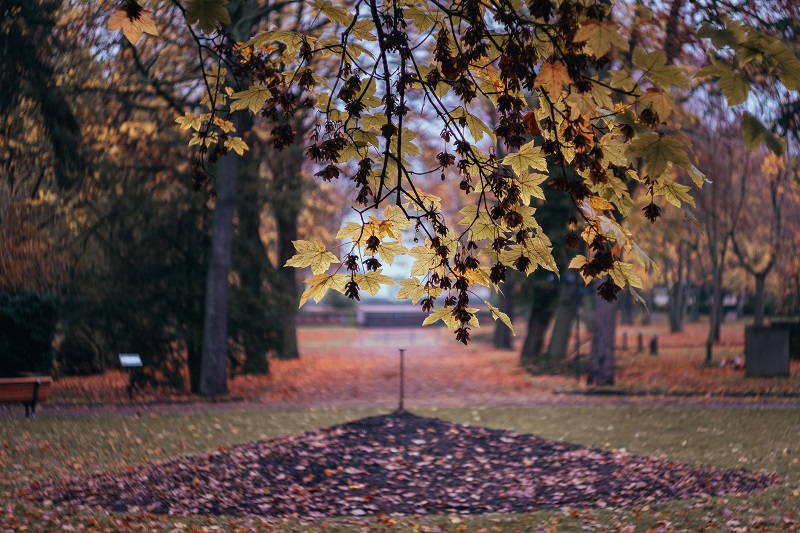
This is Vienna’s central cemetery, and with an area of 240 hectares, it is one of the largest in the world. More than three million people are buried in the area.
The Zentralfriedhof was opened in 1874, and in addition to those who have been buried here since then, several notables have been moved here. This applies, for example, to the composers Beethoven and Schubert, who were moved in 1888, and one of the most visited graves is that of the composer Wolfgang Amadeus Mozart.
The cemetery is divided by a central axis, which runs from the grand Art Nouveau gate system from 1905 to the church in the middle, Karl-Borromäus-Kirche, which was built 1908-1910. The church is considered one of the finest church buildings in the Art Nouveau style and is also known as a memorial church for the mayor of Vienna, Karl Lueger, who died in 1910 and is buried under the main altar.
Another construction with architectural features is the crematorium, Feuerhalle Simmering, which was built with oriental inspiration in the years 1921-1922.
There are different sections in the cemetery according to denomination within, not least, the Orthodox churches. Building-wise, this is clearly seen in, for example, the Russian-Orthodox part. Here you can see a Russian church with a gilded onion dome and what else belongs to the traditional Russian Orthodox architecture.
There are also monuments and graves for those who died in war or victims of various events or accidents. The largest is for the victims during the First World War, but fires and avalanches are also represented, for example.
UNO-City is the designation for the UN buildings in Vienna. The houses in the complex were built between 1973 and 1979 and stand on a plan designed in circles, which are connected by three-sided, rounded buildings that reach a height of 120 meters.
Together with the UN buildings in New York, Geneva and Nairobi, UNO-City are the four official headquarters of the worldwide organization.
In the middle of the green area Donaupark, which is close to the banks of the Danube River, stands the tower Donauturm. It was built in the years 1962-1964 as a viewing tower. The Donauturm is 252 meters high with the viewing balcony located 150 meters up. In clear weather, you can see about 80 kilometers away, and of course this gives a nice view of the whole of Vienna and the surrounding area. At a height of 160 and 170 meters there are rotating restaurants where you can enjoy the food and the view in peace and quiet.
The area of Carnuntum was the civil center of the Roman colonization of the Austrian area. In the 100-300s, the city was at its peak and had approximately 50,000 inhabitants. As an archaeological excavation area, Carnuntum is an open-air museum, where a walk gives good insight into the size of the city and its various facilities. You can see ruins of, among other things, two amphitheatres, bathing and temple facilities, and not least the impressive Hedningeport/Heidentor, which was built in 354-361 as a triumphal monument for Emperor Canstantius II.
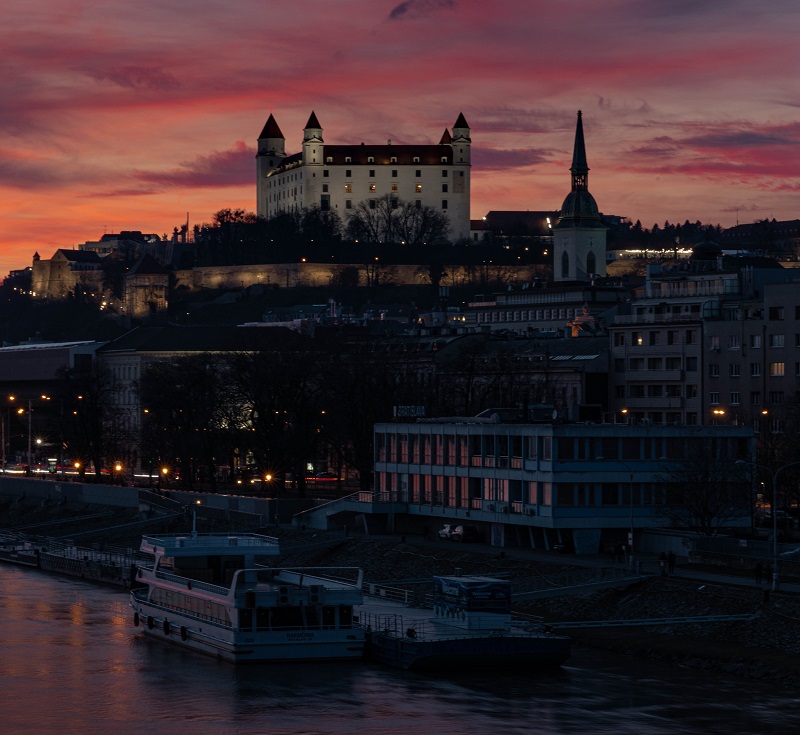
The Slovak capital of Bratislava is one of Central Europe’s magnificent and at the same time very interesting cultural cities, and you can clearly sense a certain resemblance to other capitals and metropolitan cities of the historic Habsburg Empire, of which Bratislava was a central part for many years.
Beautiful squares and an old town with many atmospheric streets invite you to take wonderful walks between countless buildings from, for example, the Baroque era, and at the same time it is a good idea to enjoy the elegant and quite diverse architecture that characterizes the cityscape.
The town of Klosterneuburg is located just north of Vienna, high above the course of the Danube. The town’s name comes from the Augustinian monastery that was founded here in 1114 by Leopold III. The monastery is today the city’s biggest attraction. At its foundation, it was one of the largest in the country, and much of the land on which Vienna’s northwestern suburbs were eventually built belonged to the monastery.
The largest part of the complex that can be seen today was built or rebuilt from 1730 and in the next 100 years or so. However, the towers only got their neo-Gothic style in the 1880s. Some older buildings have been preserved, such as the Leopold Chapel from 1318. The chapel contains the famous Verdun altar from 1881. On the beautifully executed altarpiece, parts of the Bible are depicted through 81 enamel pictures.
Designer Outlet Street 1
mcarthurglen.com
Wagramerstraße 81
donauzentrum.at
Gablenzgasse 5-13
lugner.at
Vösendorf
scs.at
Graben, Kohlmarkt, Mariahilfer Straße, Kärntner Straße
Haus des Meeres
Fritz-Grünbaum-Platz 1
haus-des-meeres.at
Naturhistorisches Museum
Maria-Theresien-Platz
nhm-wien.ac.at
Prater
Praterstern
prater.at
Technisches Museum Wien
Mariahilfer Straße 212
technischesmuseum.at
Tiergarten Schönbrunn
Schönbrunn
zoovienna.at
Zoom Kindermuseum
Museumsplatz 1
kindermuseum.at
In the 400s BC established Celtic tribes settlement in the Danube valley around present-day Vienna – they built an early castle. In year 9, the Romans founded the military camp Vindobona in connection with the conquest of the Austrian territory. The Romans brought about 275 vines to Vienna, and it became the start of the region’s large wine production.
Beginning in the 400s, Germanic tribes’ attacks began, which together with the weakening of the Roman Empire led the Romans in 433 to leave Vienna and the province to the females. In the following centuries, there were many battles between different peoples.
The Frankish Charlemagne established in 803 a region in the Danube valley named Ostmark, the forerunner of the later Austria. Officially, the name of Austria was first used in 996.
In 1137 Vienna was first mentioned as a city, and it developed rapidly in trade, not least because of its good location on the trade routes between East and West. In 1155, Heinrich II established his residence here, and Vienna came under the rule of the Bavarian Babenberg princes.
The Babenbergs’ reign ended in 1246, when the regent died in the decisive battles and victories in the uprising against the invading Hungarians. It created decades of political void in Vienna.
In 1273, the Habsburg Rudolf placed the Austrian territories, including Vienna, under the German-Roman Empire, which, like the Habsburg Empire, was to remain in power until the 20th century. In the 1300s and 1400s, Vienna underwent a cultural, political and religious development. The city’s university was founded in 1365, and in 1438 Vienna became the residence city of the kingdom. In 1469 the town became bishopric.
These were also the years when the energetic Habsburgs expanded their empire with the inclusion of Tyrol and Carniola in the Northern Balkans, among others. The empire was expanded to include the Netherlands, Burgundy and Spain. Its size eventually required a new form of leadership, and in 1521 the kingdom’s leadership was divided between the brothers Ferdinand and Charles.
1521 was the year of the Reformation in Vienna. Four years later, a fire ravaged large parts of the city that had to be rebuilt. In 1529 the Turks besieged the city and destroyed the outer areas. The Turks were knocked back, but Vienna was threatened and the fortresses were expanded.
In 1551, Vienna, with the help of the Jesuits, underwent a return to Catholicism. During the 30-year war, Vienna was besieged by the Swedish army, but the Swedes left the area again. Financially, the war was of great importance to Vienna, which stagnated over the years.
In 1679, the plague hit Vienna and 80,000 inhabitants perished. Only four years later, the Turks again attacked the city, this time with a colossal army in relation to Vienna’s defense. With the help of German and Polish armies, the powerful Turks were overcome and Vienna flourished again. Construction almost exploded, and it was the start of the Baroque period.
Vienna underwent a golden era with Maria Theresia as Empress and subsequently Joseph II. Reforms in favor of the citizens were introduced, Schönbrunn was listed as Vienna’s response to Versailles, and the music thrived with well-known inhabitants such as Mozart, Haydn, Beethoven and Schubert.
Napoleon occupied Vienna in 1805-1809, and it hit hard on the Habsburgs, who among other things had to give the German crown. The economy of the Habsburgs and Vienna was strained, and the Vienna Congress in 1814-1815 only started the development.
It became a revolution in 1848, when the emperor was replaced by 18-year-old Franz Josef I. Under his rule, Ringgaden was built with its splendid buildings in Vienna, and in 1867 the kingdom of the Habsburgs was changed to the double monarchy of Austria-Hungary. Vienna’s cultural life flourished and the creative environment attracted many artists.
Emperor Franz Josef died in 1916, and in 1918 the Habsburg Empire was dissolved. In 1922, Vienna became a state in the new Austrian republic.
Vienna’s status as a capital temporarily erected in 1938, when Austria became part of Adolf Hitler’s Germany. Since then, the country was part of World War II, and as a result of the war, much of Vienna was destroyed in the years 1944-1945. After the end of World War II, both the city of Vienna and the country of Austria were divided into 4 zones.
It took until 1955 before the entire Republic of Austria was established and a great economic development took place. One of the examples of Vienna’s positive development came when Vienna was elected in 1979 as one of the three UN administration cities.
In 1995, Austria and thus Vienna became part of the European Union and today it emerges as a modern capital with its many traditions and buildings, which are impressive reminiscent of the kingdom of the Habsburgs. Several major international events have also taken place over the decades; for example, in 2008 when the final of the European football championships was held in the Austrian capital.

Vienna, Austria
Overview of Vienna
Vienna is the city of elegance, and it is the heart of the former Holy Roman and Austrian empires. It is thereby the center of the fantastic history of the Habsburg dynasty and the capital of classical music, with all the magnificent buildings, the emperors and state have built during the last many centuries.
Nearly everywhere, there are historic buildings and great art that the Habsburg emperors have been at the forefront of. Enormous sums of money were invested in beauty and in the classic culture, which for many is the epitome of Baroque Vienna in particular.
Hofburg formed the center of power in the Habsburg Empire, and the castle and the many beautiful buildings in the castle complex are among Vienna’s absolute top attractions. This is also where you find the Spanish Riding School and the famous Treasury.
About the Whitehorse travel guide
Contents: Tours in the city + tours in the surrounding area
Published: Released soon
Author: Stig Albeck
Publisher: Vamados.com
Language: English
About the travel guide
The Whitehorse travel guide gives you an overview of the sights and activities of the Canadian city. Read about top sights and other sights, and get a tour guide with tour suggestions and detailed descriptions of all the city’s most important churches, monuments, mansions, museums, etc.
Whitehorse is waiting for you, and at vamados.com you can also find cheap flights and great deals on hotels for your trip. You just select your travel dates and then you get flight and accommodation suggestions in and around the city.
Read more about Whitehorse and Canada
Canada Travel Guide: https://vamados.com/canada
City tourism: https://visitwhite-horse.ca
Main Page: https://www.vamados.com/
Buy the travel guide
Click the “Add to Cart” button to purchase the travel guide. After that you will come to the payment, where you enter the purchase and payment information. Upon payment of the travel guide, you will immediately receive a receipt with a link to download your purchase. You can download the travel guide immediately or use the download link in the email later.
Use the travel guide
When you buy the travel guide to Whitehorse you get the book online so you can have it on your phone, tablet or computer – and of course you can choose to print it. Use the maps and tour suggestions and you will have a good and content-rich journey.


Belvedere is a beautiful castle that sits like a lovely and elegant breather in the Austrian capital. The castle is more of a castle complex consisting of three parts; the two castles Upper Belvedere/Oberes Belvedere and Lower Belvedere/Unteres Belvedere and a very beautiful garden.
The Belvedere was built by Prince Eugene of Savoy. Eugen gave the architect Johann Lucas von Hildebrandt the task in 1714, and the large pleasure palace Lower Belvedere was already completed two years later. Lower Belvedere was not planned for much living, but rather with beautiful halls, stables and as an orangery. The central room is the Marmorsalen/Marmorsaal, in which the original figures from the Providentiabrunnen fountain on the Neuer Markt can be seen.
The garden, which is primarily located between the two Belvedere castles, is the oldest part of the complex. It was laid out according to the French model already shortly after the purchase of the land in 1700. As the Upper Belvedere is slightly higher than the Lower Belvedere, the choice fell on a terraced garden with sculptures, the theme of which is the Olympus of Greek mythology.
Upper Belvedere was originally intended as a smaller building that was supposed to act decoratively as the end of the garden. However, it was changed so that it could be the palace complex’s summer residence for Prince Eugen. The building was completed after two years of construction in 1723, but Prince Eugen still lived in the fewer living rooms in the Lower Belvedere, and the Upper Belvedere was primarily used for representation.
Later, Upper Belvedere became the residence of the Habsburgs, and the last resident was the successor to the throne, Archduke Franz Ferdinand, who was killed in 1914. In 1955, the Austrian constitution was also signed in Upper Belvedere, and thus modern Austria was formally established here.
There is both access to the garden and to both castle buildings. They are designed as exhibition rooms, but of course the buildings themselves are also worth a visit in themselves. The terrace garden is located between Upper and Lower Belvedere, but there is also a beautiful and worth-seeing facility south of Upper Belvedere.
Here in the Figarohaus is one of the only preserved apartments of the composer Wolfgang Amadeus Mozart. In 1781, Mozart moved from Salzburg to Vienna, and in the years 1784-1787 he lived here in the Figarohaus, whose name comes from the fact that Mozart, among other things, composed The Marriage of Figaro in the apartment.
The museum apartment is furnished as it was in Mozart’s time, and together with the modern exhibition about the composer’s life and works in the Mozarthaus next to the Figarohaus, the place gives an elegant overall impression of Mozart’s world.
Karlsplatz is one of Vienna’s well-known squares. It was laid out by Emperor Karl VI in the early 1700s in a different version than today’s square, which is quite busy. However, you can also see several sights on and around Karlsplatz.
The large Karlskirche dominates the impression together with the fine pavilion that stands in the middle of the square. The pavilion was built in Art Nouveau style and opened in 1899 as the Akademiestraße S-Bahn station. When the station was changed to a subway in 1981, the pavilion closed as a station.
On the north side of the square is the Musikverein concert hall, where every year there is a New Year’s concert in the impressive Gyldne Sal/Goldener Saal, where there is room for 2,000 spectators. Next to the Musikverein you can see the Künstlerhaus building, which was built as the Musikverein in the 1860s. To the south on Karlsplatz is the Technical University of Vienna, whose main building from 1816 is adorned with statues of celebrities in engineering and science.

The elegant square Maria-Theresien-Platz was laid out in the late 19th century as one of the only completed parts of the grand plan for the new Hofburg, Kaiserforum, conceived by the architect Gottfried Semper. Semper is also known, among other things, for Dresden’s famous Semperopera.
In the middle of Maria-Theresien-Platz stands Vienna’s large monument to Empress Maria Theresia, and along the sides of the square are the large twin buildings that house the art history and natural history museums in the city respectively. Both buildings were built in the Imperial Renaissance style with lavish furnishings in all rooms.
The great Habsburg Hofburg is located as a large building complex in Vienna, and you can see several museums and collections in the facility. In the entrance in the gate under the Michaelerkuppel are the Kaiserappartements, the Silberkammer and the Sisi Museum.
The Kaiserappartements were some of the imperial family’s private apartments at the Hofburg, and they are furnished as in the imperial era. The interior is primarily in Rococo, and in addition to private rooms and effects, there is also access to Emperor Franz Joseph’s study and several halls for official use.
In the Silberkammer you can see an exhibition of the imperial family’s service. In the exhibition, a long table is set up, among other things, so that you get a good impression of a dinner situation in the imperial era.
The Sisi Museum is an exciting exhibition about the beautiful Empress Elisabeth, whose person and history are surrounded by myths and good stories.
The famous Spanish Riding School is located in the Stallburg building. The institution is believed to have been established in 1572, and it got its name from the Spanish horses that were bred and trained here. The horses are known as Lipizzaner horses, and that name comes from the stud farm Lipizza, which was also founded by the emperor in the 16th century. Today, the white horses are bred at the stud farm Bundesgestüt Piber in the town of Piber.
There are different buildings for the riding school. In the period 1729-1735, Emperor Karl VI had the particularly beautifully decorated Winter Riding School/Winterreitschule built. Equestrian shows are still held here, and during the country’s imperial era, the court could take a seat in a special lodge. It was also in this hall that Napoleon’s wedding dinner in 1810 was held.

Vienna’s Neo-Gothic Town Hall was built in 1872-1883 by Friedrich von Schmidt. It houses both the city of Vienna’s administration and the mayor’s office, as well as the region’s parliament. The dominant part of the building is the central tower, which measures 98 meters in height. At the top of the tower stands the 3.4 meter tall figure Rådhusman/Rathausmann, which was cast in wrought iron in 1882.
The most impressive of the town hall’s more than 1,500 rooms and halls is the Festsalen/Festsaal, which contains statues of important people from Vienna. In front of the building is the green facility Rathauspark, which was laid out in the 1800s on an area that previously functioned as an exercise field.
Peterskirche is one of central Vienna’s atmospheric churches. Its history goes back to the early Middle Ages, but the original Romanesque building burned in 1661. The ruin was urgently repaired, but the emperor decided at the same time that a new church should be built. The new and current Peterskirche was mainly built in the years 1701-1722, but was not inaugurated until 1733.
The church was the first domed church in baroque Vienna, and despite a relatively small area to build on, it is a large and airy church space that you enter. The interior is quite overwhelming with the fine and rich stucco and other decoration.
Similar to Vienna Travel Guide
